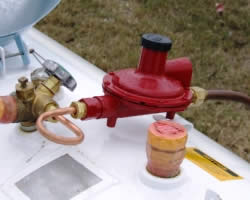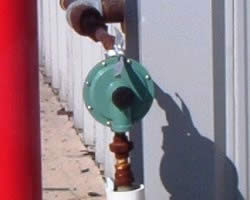Two Stage Propane System Regulators
First stage regulators serve as a primary means for pressure regulation in a two stage system. First stage regulators are sometimes referred to as high pressure regulators (although not true high pressure regulators) because they do not reduce variable tank pressures to appliance level pressure. They just lower the pressure before it goes into the gas service line.
Second stage regulators function to further decrease pressure to a usable level for appliance demand. These regulators work with the lower pressures delivered by first stage regulators and in turn, lower the pressure even more so that the propane will adequately and safely supply the demand of the appliances.
Two Stage Regulator System Overview
The reasoning behind having two separate regulators in a propane system is strictly for economy of the installation. Integral twin-stage regulators are more commonly used and are more sensible for most installations but in a situation where there is an extreme distance between the tank and house or appliance, a two stage regulator system is often the best option. The reason for this has to do with several things including pipe size, total service line distance and appliance BTU demand. An 80 foot run from the propane tank to a house with a total load being over 1,000,000 BTU would most likely benefit from a two stage system because an integral twin stage regulator will not supply the propane required that the appliances demand. If the installing propane company places a regulator at each end of the yard line, it's to save the customer money, not to make more money for the company by selling two regulators.
Two Stage System - An Explanation
To better explain the need for a two stage regulator system, take a gas powered yard blower (like a leaf blower) with a 2 inch blower tube that is 50 feet long. You'll never get the same air being pushed out the end of the tube like you would if it were only 3 feet long. You will get more air flow out of the end of the tube by attaching a much more powerful blower but as the length of the tube grows, higher powered blowers are needed. Although this example is crude, it explains how propane pressures over a great distance drop and in order to satisfy the demand of the appliances, two separate regulators may be required to deliver the required pressures. The information below explains both first stage and second stage regulators.
First Stage Regulators - Tank to Line

First stage regulators are installed at the propane tank connected directly to the service valve with a pigtail. If a first stage regulator is used in an LP Gas plumbing system, a second stage regulator must be installed downstream. In other words, a first stage regulator can't be installed independently in an LP Gas system. There must be a second stage regulator installed as well. The first stage regulator will compensate for differing tank pressures and will deliver into the gas line at a pressure of 10 pounds or less. The purpose of a first stage regulator is to deliver propane at an ample pressure to a downstream second stage regulator. That's its only job...to ensure that the second stage regulator is supplied with propane at a pressure that it needs to do its job. The variations of first stage regulators are numerous and while they are all designed to work with propane tank pressures, the outlet pressures differ by model and manufacturer. First and second stage regulators must be properly matched so that the overall gas system is safe and functional. Propane companies work with regulators every day and are able to determine what size and type of first stage regulator is needed for the requirements of the installation.
Second Stage Regulators - Line to Appliance

Second stage regulators are not used for decreasing tank pressure and therefore must be installed downstream of a first stage regulator for safe and proper operation. Any regulator seen installed next to a building, as pictured above right, is a second stage regulator. Second stage regulators work with propane at a pressure supplied by the first stage regulator (inlet pressure) and further decrease that to a pressure that can be used by appliances (outlet pressure). Most outlet pressures of second stage regulators are measured in inches water column, such as 11" water column. This is the standard propane pressure delivered to household appliances so that they can safely and properly operate. Keep in mind that second stage regulators are not designed to work with varying tank pressures. Second stage regulators are only designed to operate in combination with first stage regulators. One cannot work without the other.
